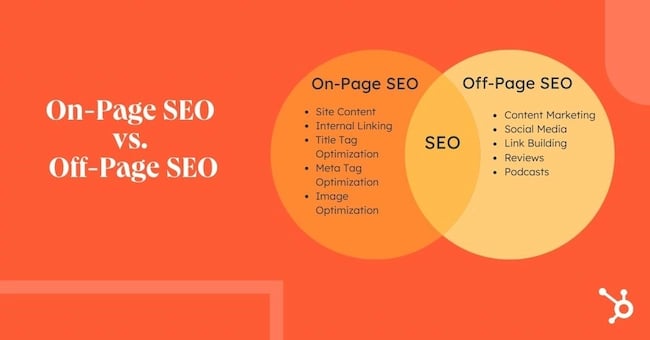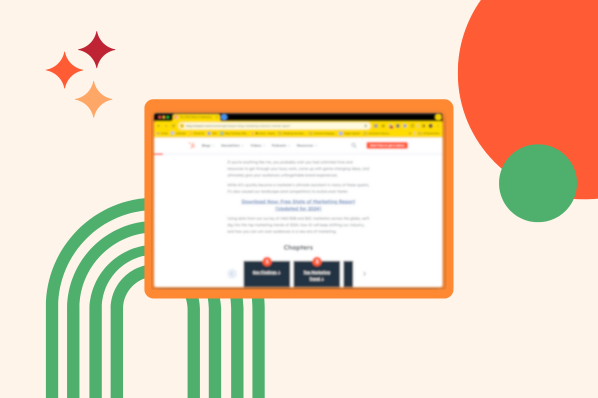Discover the key on-page SEO techniques, tips, and tricks that will skyrocket your website’s visibility and search engine rankings.

Image courtesy of via DALL-E 3
Table of Contents
Introduction to On-Page SEO
Have you ever wondered how websites show up when you search for something on Google? Well, that’s where On-Page SEO comes into play. On-Page SEO, short for On-Page Search Engine Optimization, is all about making your website better so that search engines like Google can easily find it. By using the right techniques, you can increase your website’s visibility and make it more likely to appear at the top of search results. Let’s dive into what On-Page SEO is all about and why it’s crucial for making your website easy to find.
What is SEO?
SEO, which stands for Search Engine Optimization, is like a secret language that helps websites communicate with search engines. It involves using specific strategies to improve your website’s visibility and attract more visitors. Think of it as a way to make your website more attractive to search engines, so they show it to people searching for information related to your site.
Why is On-Page SEO Important?
On-Page SEO plays a vital role in ensuring that every page on your website is easy to understand for both search engines and visitors. By optimizing your web pages with the right keywords, tags, and content, you can improve your chances of getting noticed and driving more traffic to your site. With On-Page SEO, you are essentially making your website more search engine-friendly, which can lead to better visibility and higher rankings in search results.
Choosing the Right Keywords
In the world of websites and search engines, keywords play a crucial role in helping your pages get noticed. But what exactly are keywords, and how can you find the right ones to use on your website? Let’s dive in and explore the fascinating world of choosing the right keywords.
What are Keywords?
Keywords are like magic words that people type into search engines like Google to find what they’re looking for. They are the secret codes that unlock the doors to information on the internet. For example, if you’re searching for the best pizza in town, you might type in keywords like “best pizza near me” or “delicious pizza restaurants.” By using the right keywords, search engines can match your query with relevant web pages.
How to Find Keywords
Finding the perfect keywords for your website doesn’t have to be a daunting task. There are simple ways to uncover the best words and phrases that people are typing into search engines. Put yourself in the shoes of someone looking for information on your website. What words would they use to search? You can also use free tools like Google Keyword Planner to see what terms are popular or check out what keywords your competitors are using. By doing some keyword research, you can uncover the hidden gems that will lead more visitors to your site.
Title Tags and Meta Descriptions
When it comes to On-Page SEO, two crucial elements that play a significant role in attracting visitors to your website are Title Tags and Meta Descriptions. Let’s dive into what these are and why they are essential for your online presence.

Image courtesy of www.linkedin.com via Google Images
What are Title Tags?
Title tags are the names of web pages that show up in search results. They act as a headline for your page, informing both search engines and users about the content on that specific page. It is essential to craft title tags that accurately reflect the topic of your page to increase the chances of getting clicked on.
What are Meta Descriptions?
Meta descriptions are short summaries of web pages that also appear in search results. While they do not directly impact search rankings, they do influence whether users decide to click on a link or not. A well-written meta description can entice users to visit your page by giving them a glimpse of what to expect.
Now that we understand what title tags and meta descriptions are, let’s see how you can leverage them to improve your website’s visibility and click-through rates.
Creating High-Quality Content
High-quality content is like a treasure chest full of useful information. It is well-written, easy to understand, and gives the reader exactly what they are looking for. Imagine you are searching for the best pizza place in town, and you come across a website that not only lists the top-rated pizza spots but also includes mouth-watering photos, detailed descriptions, and helpful reviews – that’s high-quality content!
Tips for Writing Great Content
Writing great content is like telling a captivating story that keeps your readers hooked from start to finish. Here are some tips to help you write amazing content:
1. Keep it simple: Use easy words and short sentences to make your content easy to read.
2. Be informative: Provide helpful and accurate information that answers your readers’ questions.
3. Make it interesting: Add some fun facts, personal experiences, or anecdotes to spice up your content and keep your readers engaged.
4. Use visuals: Include eye-catching images, videos, or infographics to break up the text and make your content more visually appealing.
5. Stay organized: Use headings and subheadings to organize your content and make it easy to navigate.
By following these tips, you can create high-quality content that not only attracts visitors but also keeps them coming back for more!
Using Header Tags
Header tags (like H1 and H2) are essential elements in creating well-organized content on a website. They help to structure information by providing clear headings and subheadings that make it easier for both visitors and search engines to understand the content.
Image courtesy of blog.hubspot.com via Google Images
What are Header Tags?
Header tags are like signposts that guide readers through your content. The H1 tag is typically used for the main title of a page, while H2 tags are used for subheadings. By using header tags correctly, you can break up your content into easily digestible sections that are visually appealing and easy to follow.
How to Use Header Tags
When using header tags, it’s important to follow a hierarchical structure. Start with an H1 tag for the main title of your page, and then use H2 tags for subheadings that divide your content into different sections. Avoid skipping levels, such as going from an H1 directly to an H3, as this can confuse both readers and search engines.
Optimizing Images
Images on a website can make it more appealing and interesting but did you know that they can also help with your website’s visibility? Let’s talk about how optimizing images can make a big difference!
Why Optimize Images?
When you optimize images, you’re making sure that they are the right size and that they have something called ‘alt text’. This helps the web pages load faster, which is important because nobody likes waiting for a page to load. Also, search engines like Google can’t ‘see’ images like we can, so having alt text helps them understand what the images are about and can improve your website’s visibility in search results.
How to Optimize Images
Adding ‘alt text’ to your images is like giving them a little description. This helps people who can’t see the images understand what they are about. It’s also a great place to add keywords that relate to the image so that search engines can understand your content better.
Another important thing to do is to reduce the file size of your images. Large image files can slow down your website, especially on mobile devices. There are free tools online that can help you compress your images without losing too much quality. This way, your website can load quickly on any device!
Internal Linking
Internal linking is an important part of making your website easy to navigate for both visitors and search engines. By adding links to other pages within your own website, you can help guide users to related content and make it easier for search engines to crawl and index your site.

Image courtesy of blog.hubspot.com via Google Images
What is Internal Linking?
Internal linking is like connecting the dots between different pages on your website. It’s a way to show visitors that there is more to explore and learn, guiding them to related topics they might be interested in. This also helps search engines understand the structure and hierarchy of your website, which can improve your site’s overall visibility.
Why is Internal Linking Important?
Internal linking plays a key role in improving user experience by allowing visitors to easily find more information on topics they are interested in. It keeps users engaged on your site for longer periods, reducing bounce rates. From a search engine perspective, internal linking helps search engine bots discover and index new pages on your website, boosting overall visibility in search results.
Mobile-Friendly Design
In today’s digital age, it’s essential for websites to cater to the needs of users who browse the internet on their mobile devices. Mobile-friendly design ensures that a website looks good and works seamlessly on smartphones and tablets. This is crucial because more and more people are accessing the internet through their mobile devices, and if a website is not optimized for mobile, it may lead to a poor user experience and lower visibility on search engines.
What is Mobile-Friendly Design?
Mobile-friendly design, also known as responsive design, is the practice of creating websites that automatically adjust their layout and content to the size of the screen they are viewed on. This means that whether a user is accessing the website on a desktop, a smartphone, or a tablet, they will have a consistent and user-friendly experience without having to zoom in or out or scroll excessively.
Tips for Mobile-Friendly Design
Creating a mobile-friendly website is not as complicated as it may sound. Here are some simple tips to ensure your website is optimized for mobile devices:
- Use a responsive design that automatically adjusts to different screen sizes.
- Avoid using large files or images that may slow down the loading time on mobile devices.
- Ensure that text is easy to read without the need for zooming in.
- Keep navigation simple and prioritize the most important information for mobile users.
- Test your website on different devices to ensure it looks and functions well across various platforms.
By following these tips and investing in a mobile-friendly design, you can enhance the user experience and improve your website’s visibility on search engines, ultimately driving more traffic to your site.
Conclusion
In this article, we have explored various essential techniques for better visibility through On-Page SEO. By implementing these strategies, website owners can improve their chances of being seen by search engines and visitors alike. Let’s quickly summarize the key points discussed:

Image courtesy of blog.hubspot.com via Google Images
Recap of Key Techniques
Firstly, we emphasized the significance of choosing the right keywords that accurately reflect the content of web pages. These keywords help search engines understand the relevance of the content to user queries. It is crucial to conduct proper keyword research to optimize content effectively.
Next, we highlighted the importance of title tags and meta descriptions in providing concise and informative summaries of web pages. These elements not only help search engines comprehend the content but also entice users to click through to the website.
We also stressed the necessity of creating high-quality content that is not only informative and engaging but also user-friendly. Valuable content attracts and retains visitors, which can positively impact search engine rankings.
Header tags were discussed as a way to organize content effectively by utilizing headings and subheadings. Proper use of header tags can improve readability and navigation for both users and search engines.
Optimizing images by adding descriptive alt text and reducing file sizes was presented as a method to improve page load times and enhance user experience. Search engines also rely on image optimization to better understand the content of web pages.
Internal linking was introduced as a strategy to improve website navigation and enhance the interconnectedness of content. By linking related pages, website owners can guide visitors to valuable information and assist search engines in crawling the site more efficiently.
Lastly, we discussed the importance of mobile-friendly design in ensuring websites are accessible and functional across various devices. With the rise of mobile usage, it is crucial for websites to be responsive and provide a seamless experience for users on smartphones and tablets.
By incorporating these On-Page SEO techniques into their website optimization strategies, website owners can increase their visibility in search engine results and better meet the needs of their audience. Remember, a well-optimized website is not only easier to find but also more likely to attract and retain visitors. Happy optimizing!
Want to turn these SEO insights into real results? Seorocket is an all-in-one AI SEO solution that uses the power of AI to analyze your competition and craft high-ranking content.
Seorocket offers a suite of powerful tools, including a Keyword Researcher to find the most profitable keywords, an AI Writer to generate unique and Google-friendly content, and an Automatic Publisher to schedule and publish your content directly to your website. Plus, you’ll get real-time performance tracking so you can see exactly what’s working and make adjustments as needed.
Stop just reading about SEO – take action with Seorocket and skyrocket your search rankings today. Sign up for a free trial and see the difference Seorocket can make for your website!
Frequently Asked Questions (FAQs)
What is the Difference Between On-Page and Off-Page SEO?
On-Page SEO is all about what you do on your own website to make it more visible to search engines like Google. This includes things like using the right keywords, optimizing images, and creating quality content. On the other hand, Off-Page SEO focuses on activities outside of your website, such as getting other websites to link back to yours. Both On-Page and Off-Page SEO are important for improving your website’s search engine rankings.
How Often Should I Update My Content?
It’s a good idea to update your website content regularly to keep it fresh and relevant for your visitors. You can set a schedule to review and update your content every few months. This could involve adding new information, updating images, and making sure that all links are still working properly. By keeping your content up-to-date, you can continue to provide valuable information to your audience and improve your website’s visibility in search engine results.







